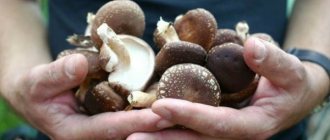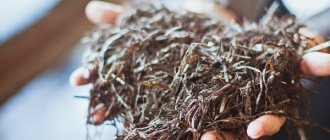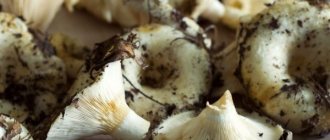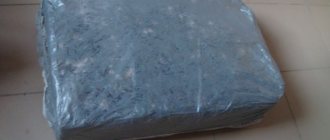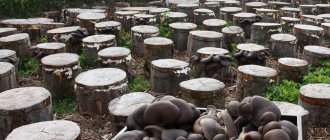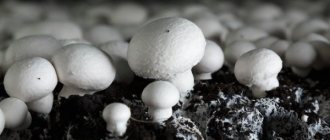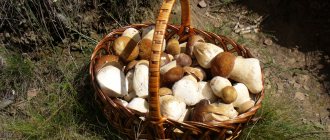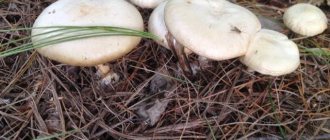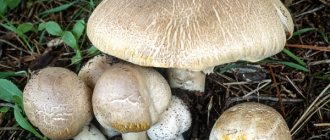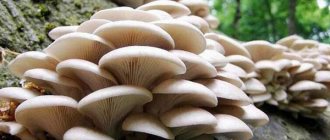The nuances of growing mushrooms in the country and in the garden
Four reasons why mushrooms grown in a summer cottage are preferred:
• Lack of competition with other mushroom pickers;
• The result is almost independent of the weather.
How to properly transfer mycelium
The mycelium is carefully dug out in the forest. This method is absolutely illegal and we do not recommend it. Except in cases where logging is taking place.
To plant mushrooms, choose a shaded place under a deciduous or coniferous tree.
For the first two weeks and in dry weather, the mycelium is watered every day. For watering, use a hose with a spray nozzle or a watering can with a divider. Then, depending on weather conditions, watering can be reduced, but for the mycelium to grow, on average, you need at least 1 standard bucket of water per hole per week.
Planting mushrooms with mycelium
However, before buying, don’t be lazy to read everything, otherwise our friend gave us her purchase - she doesn’t have an adult pine or spruce tree on her property, but she managed to buy camelina mycelium.
How to get mushroom seedlings?
To obtain mushroom seedlings, the caps are crushed and filled with water for a day. The ground around the tree is loosened with a flat cutter, adding mature compost. The prepared area is watered with the resulting solution. Leaves of forest trees are sprinkled on top.
By the way, the waste of fruiting bodies from your own plantation also needs to be infused and watered with it on an already planted mushroom bed under a tree.
Basic rules for caring for mycelium:
• Digging is not used on the dacha plot (at least for 2-3 years).
• Plant and food waste is constantly returned to the garden.
• The soil should not be dry. The place where mushrooms are planted requires constant watering.
• In spring, biostimulants are added to the soil. They accelerate the growth of mushrooms, strengthen their immune system, increase productivity and shorten the growing cycle. You can purchase dietary supplements in stores that sell seeds and related products.
Experience in using mycelium for the benefit of higher plants
Constantly adding sawdust mulch, Altai microbiologist A. Kuznetsov uses and actively promotes agricultural technology based on the ability of fungi to form a symbiotic relationship with higher plants. He noticed that in old abandoned orchards there were pigs, trumpet mushrooms, milk mushrooms, and russula. In such gardens, trees and berry gardens do not get sick, young seedlings begin to bear fruit faster. Even demanding remontant strawberry varieties in such conditions do not need to renew the plantation every 4 years:
If the appropriate conditions are created, then cultivated plants do not even grow their own feeding roots, but use external fungal mycorrhiza (fungal roots) for drinking and nutrition. Mycorrhiza is also good for garden plants because it is perennial and, in addition to nutrition and water, provides plants with valuable enzymes, hormones, immunostimulants, and even maintains a kind of information connection between plants.
What else should I add for keen mushroom growers and gardeners? Yes, in large cities there are also such options when mycorrhiza mushrooms are sold immediately with a symbiont plant; they are easiest to grow in the country; they themselves would be happy to buy such beauty:
Growing mushrooms in the country and in the garden requires certain skills. To acquire them, it may be better to start with oyster mushrooms. It is a saprophytic fungus that does not form mycorrhiza, and it is quite resistant to diseases, so it can be grown even in winter in a suitable room on a substrate of sawdust or small logs. And if the purpose of growing mushrooms is not only food, then take a closer look at mycorrhizal mushrooms for the garden.
Did you like the article? Subscribe to the channel to stay up to date with the most interesting materials
Source
Adding an article to a new collection
Growing mushrooms in the country is convenient because you can control this process, creating the most favorable conditions for their growth. And what about in the forest: there was a dry summer, and then early frosts of the soil and that’s it - there will be no harvest of forest mushrooms! If you don’t want to depend on the vagaries of nature, feel free to try growing mushroom plantations on your site.
Read also
Coniferous plants: Plant a twig and you get a Christmas tree
It is customary for gardeners to propagate berry and ornamental shrubs by cuttings, but we usually buy coniferous plants in expensive containers. Meanwhile, some species can be propagated by cuttings
What fruits can you grow at home?
What's New Year without fruit? And they all have seeds. They can be collected and sown in pots. And after some time there will be a real tropical forest on the windowsill! We tell you what exotic fruits you can grow at home from seeds
New items with weirdness: Orange cabbage and white beets
Active sales of seeds have begun in stores for summer residents. What interesting things are offered in the 2019/2020 season?
Choosing the best water heaters for a summer residence
The problem of lack of hot water in a country house is quite acute. KP has prepared for you the top 7 devices that can solve it
Picking peppers in 2022
Peppers take a long time to ripen, so seeds for seedlings are sown at the end of February
Why is the tinder fungus dangerous?
How to remove it and save trees after the fungus has settled on them
Why is the tinder fungus dangerous on the site and how to remove it?
Gardeners consider this fungus a parasite.
How to cover seedlings for the winter: step-by-step instructions from agronomists
How to properly cover seedlings for the winter and preserve them until spring if you didn’t manage to plant them on time, we tell you in our material
And in an ordinary two-room apartment, gardens can bloom! A Krasnoyarsk woman grew a crop of citrus fruits, pomegranates and avocados on her windowsill
With proper care, everything will grow, the girl is sure [video]
Effective remedies for garden pests
If you feed birds in the garden in the fall and winter, they will destroy most pests! True, not all birds are equally useful. And in order to attract the right people, you need to know how to feed them
Growing porcini mushrooms (boletus)
This handsome man, the king of all mushrooms, can be safely moved from the forest to your own plot, and if the outcome is favorable, you will receive an impressive harvest next year. There are several ways to breed forest boletus.
Mycelium transplant
Few resort to this method, since the outcome of the operation depends on careful adherence to the technology. Judge for yourself, it is quite difficult to dig up a mycelium and move it to your site without damaging it. Nevertheless, many have succeeded, and you should try it too.
The transferred mycelium should interact with the roots of shrubs and trees, so choose a place on the site where you have deciduous or coniferous trees and bushes! It is extremely important to plant the white mushroom under the same tree from which the mycelium was dug out.
So, choose a suitable place on your site and prepare the ground next to the desired tree. To do this, remove 20-30 cm of the top layer of soil at a distance of 0.5 m from the tree trunk. At the bottom of the formed hole, lay ready-made compost from fallen leaves and tree dust, and sprinkle a small layer of earth on top. Now you can lay a layer of soil with mycelium, water it and sprinkle it with a layer of leaves. If the weather is dry in the first 14 days after planting, periodically water the mycelium.
Growing mushrooms from mycelium
One of the most popular methods among mushroom pickers. You can buy ready-made mycelium - it is freely available in many garden stores. Before implementing this method, prepare the site and soil. Choose a location in the shade of trees where the soil is moist. At a distance of 0.5 m from the tree trunk, remove the top layer of soil to a depth of 0.5 m. Calculate the area of the hole in advance based on the amount of mycelium acquired.
This is what mushroom mycelium looks like
Prepare a substrate from dust, sawdust and leaves. Place it on the bottom of the hole in a layer of about 20 cm. Sprinkle it with soil on top (about 10 cm). Next, lay a mixed layer of soil and compost. Now you can lay mycelium mixed with soil on top of this. Distribute it by hand, compacting it evenly. Sprinkle soil on top and water, cover with fallen leaves.
Ready-made substrates for planting porcini mushrooms, as well as mycelium, are sold in specialized stores. These mixtures are an excellent alternative to forest mycelium. After planting the mycelium, the area must be watered regularly. If planting the mycelium is successful, the harvest will appear next year. This mycelium can bear fruit in 2 to 5 years.
Mushroom seedlings
The easiest way to grow porcini mushrooms is from mushroom seedlings. To do this, just finely chop or mince the mushroom caps. Then pour the resulting substance with water and leave for a day. During this time, you can start preparing the site. Dig up the soil under the selected tree and generously fertilize it with compost (same as in the methods described above). Pour mushroom infusion over the prepared area and sprinkle leaves on top.
In cold winters, do not forget to sprinkle the mycelium with compost, and, if necessary, cover with polyethylene or roofing felt.
Adviсe
Many people are interested in how to grow mushrooms in the country so that there is a good harvest. There are several tips that you can follow to achieve good results:
- It is better to choose a planting site in the shade;
- if the soil lacks moisture, you need to water additionally;
- mushrooms are planted no further than 1.5 meters from the tree, in the cool season;
- Mushrooms do not take root well near fruit trees.
Now you know everything to successfully grow mushrooms.
Growing boletus (redhead)
As you already understood from the name, this mushroom mainly grows in aspen groves. Sometimes it can be found in mixed forests. If you undertake to grow a mushroom in the country, then the issue of choosing a site should be approached as carefully as in the case of porcini mushroom.
Boletuses can be bred using:
Spores form on the underside of the caps of overgrown mushrooms. This is what you should prepare: add water and leave for several hours. Use the resulting infusion of spores in water to water the area you have chosen for growing mushrooms. The caps can also be dried and used as seed. Germinating spores form mycelium (mycelium).
Collect young boletuses in the forest, chop them and bury them in your area in the top layer of soil in the shade of trees.
Wild mycelium can be collected from the forest by digging up along with the soil and trees. This way you will move the mycelium to your site, just as in the case of boletus mushrooms. Or you can buy ready-made mycelium in the store.
Setting up a mushroom plantation and care
Prepare compost. Spread a plastic film on the ground, lay leaves and wood dust with manure on it in layers, taken in a ratio of 9:1. Fill the pile with warm water and leave for a week. During this time it should warm up to a temperature of 35-40°C. Now you can shovel it until smooth and leave it for another 5 days.
Redheads can be planted from mid-May to September (in warmer regions - from early May).
In the selected area around the tree, dig a hole 30 cm deep and 2 sq.m. in area. If the tree's roots are at or close to the surface of the soil, remove only the top layer.
Fill the hole with compost. If it is deep, then lay the compost to ground level; if it is shallow, lay it out in layers, alternating compost (10-12 cm) and soil (5-6 cm), until the height of the layers reaches 50 cm above ground level.
Then, at a distance of 25-30 cm, make holes 20 cm deep. Dip pieces of boletus mycelium into them and cover them with soil. Immediately water the plantation with water at the rate of 20 liters per 1 sq.m and cover with a layer of fallen leaves or forest litter.
Don’t forget to insulate the mycelium for the winter
In order for the mycelium to take root, it is useful to feed it with a sugar solution: 10 g of sugar per 10 liters of water. In summer, keep the soil slightly moist. Water the area periodically, especially during dry periods. For the winter, cover it with a layer of fallen leaves, moss or spruce branches, and in the spring do not forget to remove them.
Under favorable conditions, boletus fruiting begins the very next year after the plantation is established. The yield is 5-15 mushrooms per 1 sq.m. With proper care, the mushroom clearing will delight you with a harvest for 4-5 years. After this period, the mushroom mycelium must be replanted using the same method.
Harvesting
So, we looked at how to grow mushrooms in your own country house. In conclusion, let’s learn a few important rules that will come in handy when it’s time to pick mushrooms. Mushrooms should not be picked - this can damage the mycelium to such an extent that it will stop bearing fruit. You need to carefully cut them off with a sharp knife near the very base of the leg.
Even if the recipe only requires the cap, cut everything off at the root: the remaining stem will rot and this process will quickly cover the entire mycelium. It is not recommended to use overripe mushrooms - they accumulate harmful substances and this can happen even if your dacha is located far from enterprises or a highway. It is advisable to cook or preserve the harvested crop as soon as possible.
How to grow boletus mushrooms
The next “forest dweller” beloved by many mushroom pickers is the boletus, which is also not difficult to grow on your own.
The boletus, like any forest mushroom, for normal life and growth requires not a stump, but a living tree. From its root system, the mycelium absorbs carbohydrates and amino acids, giving the tree moisture, mineral compounds and natural antibiotics that protect it from pests and diseases. Therefore, it is extremely important that the mushroom zone is as close as possible to the natural habitat of the fungus.
As for the growing methods, they are the same as for boletus and boletus.
Reproduction by spores
Growing from fruiting bodies
Select young boletus specimens, chop them and bury them in the top layer of soil next to the root system of the tree. The fruiting bodies form mycelium, and within a year, with good soil moisture, you can get a small harvest of 2-3 mushrooms.
Alternatively, in rainy weather, you can scatter small pieces of young mushrooms under the trees and cover them with fallen leaves. The formation of mycelium will be no less effective.
Mycelium transplant
This is a labor-intensive and not always effective process. Find a young tree in the forest with boletus under it. Carefully dig up the mycelium and transfer it to your site. Place it under a deciduous or coniferous tree.
Ecology and distribution
The habitat of milk mushrooms still remains a mystery. They form mycorrhizae with deciduous trees (birch). It is worth considering the age of the trees - the mushroom “clump” requires several years to develop. Milk meadows allow you to collect a large number at a time.
Requires compliance with the following conditions:
- nutritious soil;
- moisture;
- the ability to save water;
- sunny place.
Site requirements depend on the variety. Do not search in dry or heavily marshy areas.
Growing saffron milk caps in the country
Another wonderful mushroom that is so easy to “domesticate” is saffron milk cap!
There are several ways to grow a plantation of saffron milk caps.
Sowing mycelium
As in previous cases, collect the caps, but this time of old mushrooms. Cut them finely and, after drying them on a cloth, carefully place them on damp soil. Tamp it down well, cover it with moss and water it with warm water. After 2 weeks, lift the moss: if greenish-purple threads are visible underneath it, similar to ordinary mold, and the caps have disappeared, then the mycelium has taken root.
Spruce saffron milk caps should be placed under spruce trees, and pine saffron milk caps should be placed under pine trees.
Transfer of mycelium
This method is also very effective in the case of sowing saffron milk caps. Carefully dig out the mycelium with a layer thickness of at least 25 cm, being careful not to damage it. Plant the mycelium as soon as possible so that it does not have time to dry out, and do not forget to regularly moisten the soil.
Of course, not every summer resident can grow a crop of wild mushrooms on their own the first time. However, don't despair. Try to tame different “forest inhabitants”, look for optimal methods of breeding, and very soon this labor-intensive process will be rewarded with the first harvest of homemade mushrooms.
Source
Winter honey fungus
A fairly common mushroom in natural conditions, which is also cultivated.
- you need to prepare a substrate, you will need: wood, both coniferous and hardwood will do, sawdust and shavings, bran; organic additives, ash, bone meal. Organic additives should be 30%, the rest is wood shavings (sawdust). The components are poured with water while stirring. It is necessary to achieve a substrate humidity of about 60%;
- The resulting mixture is half filled with ordinary glass jars (usually liter), closed with lids and sterilized by steam for 5 hours; a day later, repeat sterilization;
- Using a sterile instrument, a thin layer of mycelium (2-4 mm) is applied to the substrate; this operation must be carried out quickly so as not to introduce anything into the sterile environment; quickly close with a lid;
- In order for the mycelium to germinate well in the room, you need to maintain a temperature of 20-25 o C
; - when the mycelium has germinated on 90% of the entire substrate, the lids can be removed; Move the jars to a dark room where the temperature will not exceed 14 o C, humidity about 85%;
- after 2 weeks, the rudiments of fruiting bodies should appear, the temperature will now need to be maintained at 9-12 o C, the humidity will still be 80-85%, artificial lighting (50 lux), good ventilation will be needed;
- to keep the mushrooms in an upright position (they have thin and long legs), “funnels” are made from thick paper around the neck of the jar.
Typically, the yield from one “sowing” includes two or three waves. After this, the jars are emptied and washed, then the process is repeated again.
Thus, you can grow various mushrooms, whichever you like best. Each technology has its own characteristics and difficulties, however, your efforts will be rewarded with a good and environmentally friendly harvest of delicious mushrooms.
And a little about secrets...
Have you ever experienced unbearable joint pain? And you know firsthand what it is:
- inability to move easily and comfortably;
- discomfort when going up and down stairs;
- unpleasant crunching, clicking not of your own accord;
- pain during or after exercise;
- inflammation in the joints and swelling;
- causeless and sometimes unbearable aching pain in the joints...
Now answer the question: are you satisfied with this? Can such pain be tolerated? How much money have you already wasted on ineffective treatment? That's right - it's time to end this! Do you agree? That is why we decided to publish an exclusive interview with Professor Dikul, in which he revealed the secrets of getting rid of joint pain, arthritis and arthrosis.
Milk mushrooms: what do they look like, where do they grow and can they be grown?
Milk mushrooms are representatives of the Russulaceae (Russula) family, the genus Lactiferae (which means that when the fruiting body, which has increased fragility, is broken, milky juice flows out) and the lamellar order. In European countries, all varieties of milk mushrooms are considered inedible due to their bitter taste, and some classify them as poisonous mushrooms, but in Rus' it has always been the “king” of mushrooms. They are classified as conditionally edible and inedible species.
Description of appearance
The cap in all species is fleshy, usually up to 7-10 cm in size, less often up to 20 cm. Initially, it is flat with a depressed center and curled shaggy edges. Later it takes the shape of a “funnel”. The skin of the mushroom is slimy and sticky, with rare exceptions. Therefore, it is often covered with needles, blades of grass and other natural debris. The leg is hollow inside, smooth. In some species it thickens towards the bottom.
In all types of milk mushrooms, white milky juice appears at the break; in the air, it instantly curls up and changes its color. For some varieties this is a characteristic feature by which they are identified. The juice usually tastes bitter or acrid. The greater the pungency, the more time it takes to pre-treat the mushrooms - soaking.
Nutritional value of milk mushrooms
100 g of raw mushroom contains:
The energy value of 100 g of mushroom is only 18.8 kcal.
Mushrooms are rich in B vitamins - thiamine (B1), riboflavin (B2), ascorbic acid (C), and contain a small concentration of nicotinic acid (vitamin PP). But in terms of mineral composition, milk mushrooms occupy the last position among other mushrooms, since they practically do not contain macro- and microelements.
Each milk mushroom has its own preferences for soils and forests, so their distribution area is large. They are collected throughout the European part of Russia, in the south of the country; mushroom pickers of the Volga region, Transbaikalia, Siberia, the Urals and the Far East are not deprived of them. In every locality, one or another milk mushroom is found; in some areas, milk mushroom is widely represented by various species. Some species live only in oak forests, others - in birch forests, coniferous or deciduous forests. But they all love well-moistened soils. Therefore, if you go into the forest, and there is dry or sandy soil, then you will not find milk mushrooms in it. They usually go on a “quiet hunt” for milk mushrooms in July – September.
Varieties
There are several varieties of milk mushrooms, among them there are similar ones, so it is very important to correctly distinguish them from each other:
Real milk mushroom
The most valuable representative of this family. In different regions it has its own name - milk mushroom raw or white, pravsky or wet, white milk. The name reflects the main feature of the mushroom, by which it is easily recognized - the milky white color of the cap, which resembles marble. And also an equally remarkable feature is the fluffy fringe, which is located along the edges of the cap.
Milk mushrooms can vary in size. In some, the cap reaches 25 cm in diameter, in others it grows up to 9 cm. The mushroom stands on a small, cylindrical and smooth stalk, which is painted white or yellowish. The pulp has a fruity odor; the milky juice turns yellow when exposed to air. He prefers to settle in birch groves, less often in mixed forests. Distributed throughout Russia, appears from early June to September, in the southern regions - August-September.
Parchment and pepper breast
They are very similar to each other in appearance. Both of them belong to conditionally edible, low-grade mushrooms. They can be easily distinguished by the “behavior” of the milky juice in the air. In the parchment mushroom it does not change its color, but in the pepper mushroom it instantly turns blue. In addition, when you cut a pepper milk mushroom, you can see the same metamorphosis with its flesh; it acquires a blue-blue color.
The caps of young mushrooms are flat, slightly convex, and over time they take the shape of a “funnel.” And its white color gradually disappears and gives way to a yellow tint. They are also distinguished by the height of the stem - in the parchment mushroom it is longer (10 cm versus 6 cm) and narrowed downward.
These species appear at the same time in summer and autumn, preferring mixed forests. However, the peak collection occurs in August - September. Pepper mushroom is more often found in birch-oak groves on well-drained clay soils in the middle zone, parchment mushroom - in mixed forests and conifers.
Yellow milk mushroom
The cap is covered with hairs and is very slimy. The leg is short, strong and the same color as the cap. When you press it, the flesh darkens. The milky sap reacts with air to become yellowish and smells slightly like fruit.
Canine or blue breast
This conditionally edible mushroom has not found much popularity among mushroom pickers. It is often classified as a toadstool and passed by. Perhaps due to the fact that milk mushrooms usually grow in families, but this variety prefers to grow in splendid isolation. You can find it in damp places under willows and birches. The yellow cap is covered with villi, and the milky juice turns purple or lilac when exposed to air. The mushroom lives up to its name when you press the flesh. At the point of pressure, a “bruise” appears on the white surface.
Milk mushroom is bluish
"Meteor dependent" edible mushroom. Weather conditions greatly influence its taste. The velvety white funnel cap can be seen on calcareous soils in deciduous forests. The milky sap very quickly coagulates in air and turns green. The pulp also turns green when cut and smells pleasantly with a woody-honey aroma.
Swamp milk mushroom
The marsh milk mushroom grows in groups, preferring lowlands and soils with high humidity. It is collected from the beginning of summer until the end of autumn. The reddish caps with a tubercle in the center fade over time to a yellow-brown color. The leg is long, covered with fluff. The milky sap turns yellow when exposed to air.
Red milkweed, milkweed or red milk mushroom
Unlike its “brothers,” the rubella has a dry orange-brown cap covered with cracks. The milky juice of this mushroom has a sweetish taste; when exposed to air, it quickly turns brown and becomes viscous, reminiscent of molasses. This rare species is found in coniferous or deciduous forests from July to October.
Watery zone milk mushroom
This milk mushroom has furry, curled cap edges. It grows very densely. The surface of the cap is covered with a small amount of mucus. The older the mushroom, the more funnel-shaped it takes. The pulp has a strong pleasant aroma. Milky sap quickly turns yellow in air. Quite often this type of milk mushroom is confused with white milk mushroom, although it is much larger in size than its “double”, dry milk mushroom and violin. The latter are similar in appearance, but the former does not have milky juice, and the latter lacks hairy edges.
The easiest way to have a beautiful front lawn
You've certainly seen the perfect lawn in a movie, on an alley, or perhaps on your neighbor's lawn. Those who have ever tried to grow a green area on their site will no doubt say that it is a huge amount of work. The lawn requires careful planting, care, fertilization, and watering. However, only inexperienced gardeners think this way; professionals have long known about the innovative product - AquaGrazz liquid lawn
.
Mushrooms are found in mixed, deciduous forests. It is worth going out to search after a long period of rain.
There are a dozen varieties known, different in color, structure and other parameters. However, there are also general characteristics that are worth mentioning separately. This:
- grow in groups;
- in adults, the caps reach 30 cm in diameter;
- the upper part has a “notch” (on the cap);
- concentric rings are clearly visible;
- the plates have different shades.
There is a genus of mushrooms of this type - Lactarius controversus (genus Milky) from the Russulaceae family (lat. Russulaceae).
Benefits of mushroom
Milk mushrooms are rich in protein, so they are often used by vegetarians. In addition, plant protein is better absorbed by the body. They remove waste, toxins, cholesterol from the body, and prevent blockage of blood vessels. Facilitate the progression of tuberculosis and urolithiasis.
Pepper milk has a negative effect on the development of tuberculosis bacillus, inhibiting it. An extract that has antifungal and antibacterial properties is made from this species.
Experts believe that when salting milk mushrooms, chemical compounds are formed that help fight inflammatory processes and sclerosis.
How to grow milk mushrooms yourself?
Milk mushrooms are grown at home in two ways:
Preparing for sowing
First, select a site for the mycelium. Young trees should grow on it - birch, willow, poplar, hazel, whose age does not exceed 4 years. It should also be protected from direct sunlight. The soil is disinfected using a lime solution (50 g of lime is dissolved in 10 liters of water), spilling it, and fertilized with peat.
Prepare the substrate. It consists:
Sowing of seed material is carried out in open ground from May to October. When grown indoors, mycelium is planted year-round.
